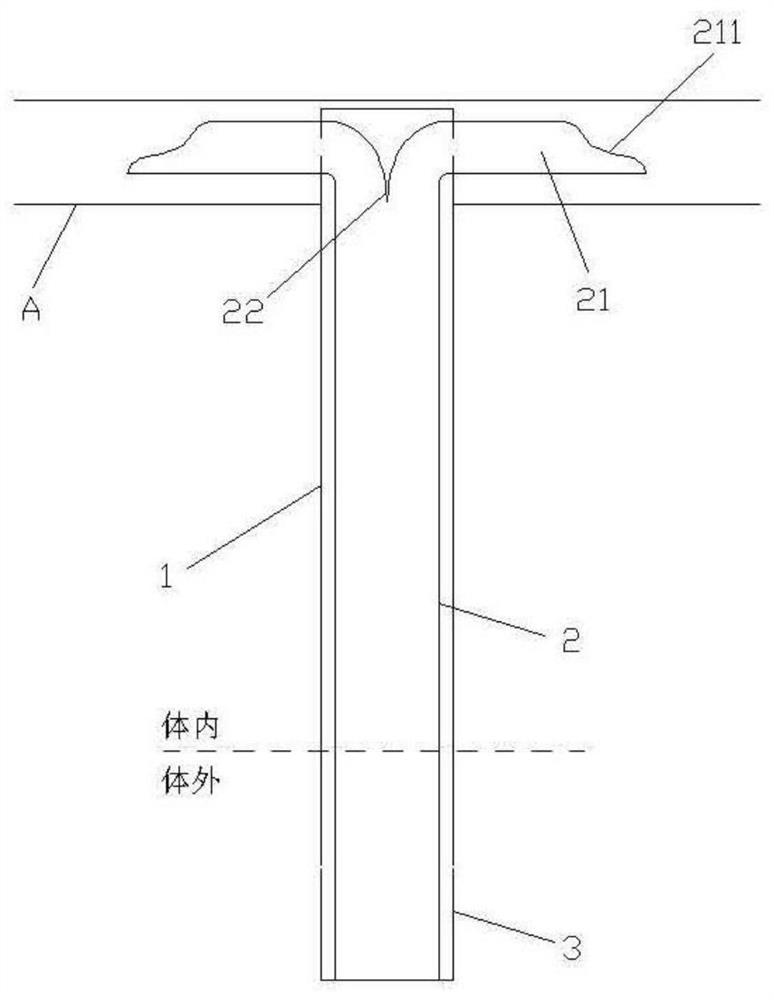Postoperative drainage tube
A drainage tube and bile duct technology, applied in the direction of the catheter, can solve the problems of T-tube-related biliary fistula, tearing of the T-tube sinus, high pressure, etc. bit effect
- Summary
- Abstract
- Description
- Claims
- Application Information
AI Technical Summary
Problems solved by technology
Method used
Image
Examples
Embodiment 1
[0030] Provide a postoperative drainage tube designed to improve the integrity, stability and safety of traditional T-shaped drainage tubes as an entry point, such as figure 1 As shown: it includes an overtube 1 and a main drainage tube 2 arranged separately. The overtube 1 is used to extend into the bile duct A and the overtube is linear. The main drainage tube 2 is placed in the overtube 1 to enter the bile duct. The main drainage The tube 2 is the main part of the bile duct to drain bile, and the outer tube 1 mainly plays a connecting role. Among them, such as figure 2 and image 3 As shown, the end of the overtube 1 extending into the bile duct is respectively provided with through holes 11 on both sides of the bile flow direction in the bile duct, and the end of the main drainage tube 2 extending into the overtube 1 is a through hole that can be flexibly entered and pulled out. active fork structure.
[0031] The two forks 21 of the movable bifurcation structure are i...
Embodiment 2
[0044] The difference between this embodiment and embodiment 1 is: Figure 5 As shown, the main drainage tube 2 is provided with a circular drainage hole 24 below the junction of the fork and the pipe (the hole can also be opened at the junction of the fork and the pipe), and the diameter of the hole is about 3-4mm. within the radiation range of the through hole 11. The setting of the drainage hole 24 can further prevent the bile from leaking out. When the bile is discharged normally, most of the bile can flow smoothly along the fork to the external end of the main drainage tube and the intestinal tract at the lower end of the bile duct. A small amount of bile can also enter the outer cannula from the through hole 11 , this part of bile can be drained into the main drainage tube through the drainage hole. In addition, the outer cannula can also provide additional protection for the bile leaking from the main drainage tube, and finally achieve the smooth drainage of all bile. ...
Embodiment 3
[0046] like Figure 6 As shown, the difference between the present embodiment and Embodiment 1 is that the through hole 11 is a semicircular hole, and the straight side is also set near the end of the outer tube extending into the bile duct, the length of the straight side is equal to the diameter of the main drainage tube, and the through hole The height is equal to the radius of the main drain. Compared with the isosceles triangular hole, the drainage effect and safety of the semicircular hole are slightly inferior, but it can also better meet the drainage needs.
PUM
 Login to View More
Login to View More Abstract
Description
Claims
Application Information
 Login to View More
Login to View More - R&D
- Intellectual Property
- Life Sciences
- Materials
- Tech Scout
- Unparalleled Data Quality
- Higher Quality Content
- 60% Fewer Hallucinations
Browse by: Latest US Patents, China's latest patents, Technical Efficacy Thesaurus, Application Domain, Technology Topic, Popular Technical Reports.
© 2025 PatSnap. All rights reserved.Legal|Privacy policy|Modern Slavery Act Transparency Statement|Sitemap|About US| Contact US: help@patsnap.com



